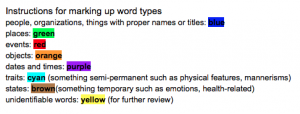Learning how to mark up our documents and then taking what we learned and applying it to our journal entires has allowed me to obtain a deeper understanding about the way that Linn writes about the war. Although the process was tricky and frustrating at points purely because of my lack of experience, I believe that it brought focus to the specific types of things that Linn talks about when he is writing. For example, when going through the version of the Google Docs that was marked up with colors, it was clear that some of the colors were used more than others. For me, I would say that blue and orange were the two most used, while purple, brown, and cyan were the least used. This comments on Linn’s writings because it gives us insight into his writing style, with a focus on people and objects. Although he is descriptive in some places, he sometimes jumps from topic to topic, which is why we see less cyan, brown, and purple.
A lot of what Pierazzo talks about in her piece was visible in our process. For example, there was a large variety in the amount of tagging that occurred, with some people tagging most words, while some just picked out the important ones. This resonates in Pierazzo’s article when she says, “So, we must have limits, and limits represent the boundaries within which the hermeneutic process can develop”(466). One of my paragraphs is below (A), and i chose to only tag the words that I thought were important and relative.


Although I think i did not make a mistake in being sparse, other people heavily marked up their entries (B) which made me come to think about how they thought those words were important compared to how I choose to select my words. Again, this links back to Pierazzo when she says that a digital edition includes words and sections that are “considered meaningful to the editors” (475) and “that one cannot declare once
and for all which features should be included” (475). The degree to which each person marked up their piece was one of the most interesting factors when I looked over everyone else’s entries.
I also learned a lot in the editorial process, primarily that it is harder to come to conclusions on basic stuff like whether a boat is a place or object than I thought. When we were talking about the cossack and different ways to go deeper in tagging, it changed the way that i thought about this tagging and my reading. When tagging mine, i had a deep internal struggle about how to tag battery, considering that like cossack, it could be both. My struggle was the externalized when we came to class and discussed cossack. When talking about what to mark up and what not to mark up, Pierazzo says that it “depends either on the particular vision that we have of a particular manuscript or on practical constraints” (465). For me, the idea of particular vision is why we disagreed. I saw battery as an place, and when asked about cossack it made sense to me that it would be a place too. Boats represent places for me, but someone made a point that to Linn, they are objects not places, and that makes sense to me. By making it an object but adding the type boat, we were able to come to a consensus. However, considering that we spent so much time arguing over one word, it makes me dread what it must be like to go through an entire edited text. I thought that this was interesting, gave me a better look into the kinds of words and descriptions that Linn uses, and taught me some new useful skills.

 ach had its own color and we were instructed to highlight the words accordingly. For me, this was the most useful step. During this step was when I decided which words were important enough to be highlighted. For example, a person was referred to in Linn’s entry as “gentleman,” but I decided that he was someone Linn saw in passing and was not essential to be marked up.
ach had its own color and we were instructed to highlight the words accordingly. For me, this was the most useful step. During this step was when I decided which words were important enough to be highlighted. For example, a person was referred to in Linn’s entry as “gentleman,” but I decided that he was someone Linn saw in passing and was not essential to be marked up.